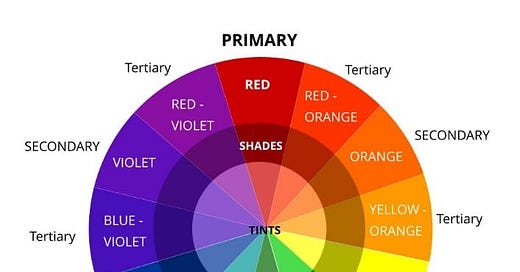The Psychology of Color: How Colors Affect Our Emotions and Behavior
Yeah....... Colours can control you.
Colours (Psychology)
Colour is integral to our everyday lives, influencing our emotions, perceptions, and decisions in ways we might not even realize. From the vibrant hues of a sunset to the calming tones of a quiet room, colours carry meanings and evoke feelings that can significantly affect our mental state. This article explores the psychology of colour, examining how different colours impact our emotions, behaviour, and even our choices.
The Basics of Color Psychology
Colour psychology is the study of how colours affect human behaviour and emotions. While individual reactions to colour can vary based on personal experiences and cultural backgrounds, certain colours tend to evoke specific feelings universally. Understanding these associations can be beneficial in various fields, including marketing, design, art, and therapy.
Primary Colors and Their Meanings
Red:
Emotions: Passion, excitement, anger, and love.
Effects: Red is a stimulating color that can increase heart rates and evoke strong emotions. It is often used in marketing to grab attention, such as in sale signs or fast-food logos.
Blue:
Emotions: Calmness, trust, and sadness.
Effects: Blue is known for its calming effects and is often associated with stability and reliability. It is frequently used in corporate branding, as it fosters a sense of trust.
Yellow:
Emotions: Happiness, optimism, and caution.
Effects: Yellow is often linked to sunshine and cheerfulness, but it can also induce anxiety if overused. It’s commonly used to grab attention, such as in warning signs.
Green:
Emotions: Nature, tranquillity, and growth.
Effects: Green is associated with nature and health. It has a calming effect and is often used in designs related to environmentalism or wellness.
Purple:
Emotions: Luxury, creativity, and spirituality.
Effects: Purple is often associated with royalty and sophistication. It stimulates creativity and is frequently used in branding for beauty and luxury products.
Orange:
Emotions: Energy, enthusiasm, and warmth.
Effects: Orange combines the energy of red and the cheerfulness of yellow, promoting feelings of excitement and enthusiasm. It’s often used in marketing to encourage impulse buying.
Black:
Emotions: Power, elegance, and mystery.
Effects: Black can convey sophistication and formality but can also signify mourning or negativity. It is often used in high-end fashion and luxury branding.
White:
Emotions: Purity, simplicity, and cleanliness.
Effects: White often represents innocence and cleanliness. It is commonly used in minimalist designs and healthcare branding to convey sterility and simplicity.
Source:- Newline Painting
Cultural Influences on Color Perception
While there are common associations with colors, cultural context plays a significant role in how colors are perceived. For example:
In Western cultures, white is traditionally associated with weddings and purity, while in some Eastern cultures, it symbolizes mourning and death.
Red can signify good fortune and happiness in Chinese culture, whereas it may evoke danger in other contexts.
Understanding these cultural nuances is crucial for effective communication, especially in global marketing and design.
Applications of Color Psychology
Marketing and Branding:
Companies harness the power of color psychology to create effective branding strategies. For instance, fast-food chains often use red and yellow to stimulate appetite and encourage quick decisions.
Interior Design:
Color choices in home decor can influence mood and atmosphere. Calming colors like blue and green are often used in bedrooms, while energizing colors like orange and yellow are favored in creative spaces.
Art and Therapy:
Artists use color to evoke emotions and convey messages. In art therapy, colors can help individuals express feelings that may be difficult to articulate verbally.
Fashion:
Clothing colors can impact how individuals feel and how others perceive them. Wearing bright colors can boost confidence, while darker colors may convey sophistication or seriousness.
Conclusion
The psychology of color is a fascinating field that reveals the profound impact colors have on our emotions and behaviors. By understanding how different colors influence us, we can make more informed choices in various aspects of life, from personal style to marketing strategies. Whether we realize it or not, color shapes our experiences, perceptions, and interactions with the world around us. Embracing this knowledge allows us to harness the power of color to enhance our lives and the environments we create.




